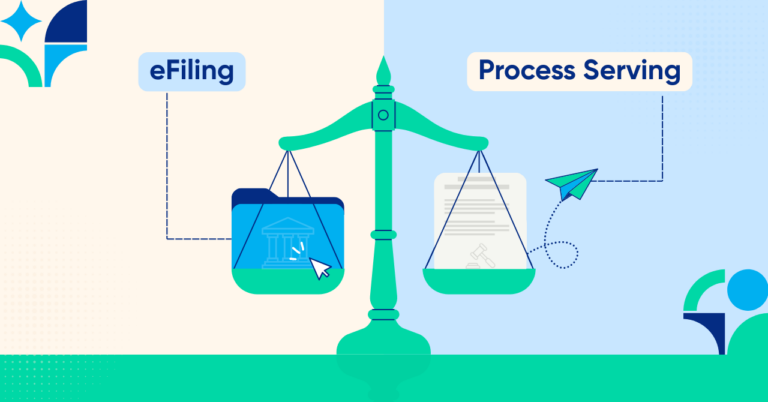Spending too much time on administrative work is a challenge for 74% of law firms. By combining eFiling and service of process into a single-vendor workflow, legal professionals can ease that challenge while moving cases forward more quickly, reducing errors, and improving the client experience.
It’s a move the makes good sense in a profession where precision matters and workflow should be an asset—not a liability.

You Read the Fine Print for a Living
As a legal professional, you know everyone watches the details. Your team wants them right and your client wants them right.
But the truth is, keeping eFiling and service of process siloed sets the stage for all kinds of errors—ranging from goofs caused by duplicate data entry to uploaded documents that don’t match.
The struggle is real. Human error rates for manual data can reach up to 5%, which means for every 100 fields filled, five could be wrong.
Keeping your eFile and service of process records in separate houses creates another potential problem further downstream: The risk that your records will be incomplete when a proof of service is challenged in court.
But there’s a simple fix for all this: Combine both tasks into one seamless process using one vendor.
Come Together, Right Now
For legal professionals who sprint against the clock daily in the race to eFile and serve court papers, instant gratification is a good thing.
In this case, the shortest route to that gratification is combining service of process and eFiling in a convenient single-vendor platform.
The ability to merge these two very common law firm tasks creates a critical efficiency gain; especially for high-volume firms that may place and manage dozens of such orders each day. The benefits extend to legal professionals throughout the firm, all the way through operations and accounting teams.
For a few very good, very rewarding reasons.

The Payoff
The move from papers and couriers to online support services was a game changer by any definition, but it didn’t fix every problem. For example, internet-enabled law firms that still bounce between separate eFiling and process serving platforms continue to risk having their data and valuable time fall between the cracks.
If that sounds like your firm, file and serve provides a way to avoid those cracks.
File and serve pays off each time you use it. Orders for the separate services of eFiling and process serving can be submitted cleanly in minutes instead of hours, with the orders following each other almost instantly.
File and serve also saves time by triggering service of process automatically after eFiling—giving you three distinct benefits.
- Verify documents quickly.
- Know the service level of the serve order.
- Upload conformed copies as soon as documents are filed.
Looking for another payoff?
Using one provider for two services centralizes the ordering process and the communication process.
Think of it this way: Your support calls for eFiling or service of process are funneled to the same operator who has access to all the information regarding both orders. One conversation, no transfers.
If issues with your eFiling or service of process orders turn up, they’re caught and fixed quickly.
This last one’s a biggie.
File and serve insulates a law firm from failure by providing a unified audit trail. That sounds important because it is important.
The trail can be defended in court vis-à-vis time stamps that confirm service was performed correctly. For firms that specialize in collections, unlawful detainer, and personal injury, where a missed deadline can mean a dismissed case, that level of visibility is indispensable.

“Let Me Check on That” is Not a Strategy
In an economy built on six-minute intervals, time management is a superpower.
So, if you’re juggling multiple tasks—and one of them happens to be service of process—you’re better off with status updates coming to you rather than playing Marco Polo with your process server.
Said another way: Combining service of process with eFiling means never having to say, “Hold on while I check”.
And, with proof after serve, you won’t need follow-up checks.
Proof after serve is a favorite especially among high-volume firms that need to file, serve, and move on—dozens of times a day.
After service is completed and the server has signed the proof, a new “file proof” order is created automatically.
It’s the legal version of, “Set it and forget it”.
Elsewhere in the office, your operations and billing team also get a piece of the benefits pie. That’s because using one provider for two services improves transparency. Virtually every CPA will find it easy to get behind:
- Reports that can show combined activity for a matter.
- Combined invoicing that makes billing disputes easier to address.

What a Good Partner Looks Like
Newsflash: 21st century law firms don’t need vendors—they need velocity, which is only going to come from a litigation support service provider that can streamline an entire process.
The first part of that equation is nationwide service of process, which is non-negotiable for the provider you choose. The second part is local expertise.
If you want a vendor who delivers meaningful results, choose one that understands court-specific nuances down to the docket. That level of insider fluency helps legal teams avoid costly rejections and unnecessary back-and-forth.
A good partner should also provide performance reporting for service of process and eFiling, which allows visibility into your operation. This will help you track and improve results over the long haul with real-time insight into filings, service attempts, and results—straight from the platform.
Integrations should also be part of your provider’s standard package. Integrations support the union of eFiling and service of process by opening a direct line to documents and data you’ll use every time you order.
To get seamless handoffs and eliminate redundancy, choose a provider whose platform integrates with case management systems like Clio, as well as document management systems such as NetDocuments, and iManage.
Smarter Workflows, Stronger Law Firms
Law firms that integrate eFiling and service of process with one reliable providers set themselves up for success. Consolidated workflows reduce risk, eliminate redundant tasks, and provide the visibility today’s legal teams need to operate with precision.
As a result, they enjoy faster turnaround times and fewer errors.
If your current provider makes you work harder just to keep things moving, it may be time to switch to a provider that’s built for the way 21st century legal professionals actually work. Contact us to speak with an account manager or book a demo to see how easy it is to make simplicity your new standard.
